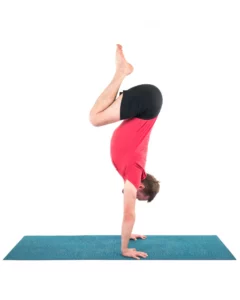Build Confidence and Strength With These 3 Tree Pose Variations

Article At A Glance
Ready to learn new Tree Pose variations? Using props in Tree Pose (Vrksasana) can enhance alignment, balance, and confidence. Learn 3 unique ways to use props to enliven your Tree Pose and build strength here.
Tree Pose (Vrksasana) variations with props can help you to better understand the subtleties of alignment and balance. Props are such valuable tools in your yoga practice to help you find support, optimize alignment, challenge your balance, and beyond. There are so many great postures to use props in, but in balance poses, they might provide the most benefit. Whether you struggle to balance in Tree Pose or you want an extra challenge, try these Tree Pose variations to find the optimal alignment for you and to build confidence and strength in this balance.
Try These 3 Tree Pose Variations to Build Confidence and Strength in Vrksasana
Find some clear wall space and grab two yoga blocks to practice these variations of this classic pose.
Tree Pose Variation #1: Blocked In

- Start facing the wall in a strong Mountain Pose with your feet hips-distance apart.
- Place one block on its longest height setting directly between your right frontal hip point and the wall and actively press your hips toward the block and into the wall. Feel your core activate as you do this.
- Hold your second block in your hands, and feel free to place one or both hands against the wall to support your balance.
- Shift your weight into your right leg and become light on your left toes.
- When you feel steady, lift your left foot off the floor and externally rotate your hip to turn your knee to face toward the left.
- Draw your left foot up into your inner right thigh as high as you comfortably can.
- Take your second block on its medium height setting and place it between your left knee and the wall. If you notice your pelvis rotating to the right, which takes your supporting leg and pelvis out of alignment, turn your block so that it’s on its lowest height setting.
- Actively press your knee against the block toward the wall.
- Option to place your hands on the wall as you focus on the alignment of your knee and pelvis.
- Observe how your left knee is oriented with respect to your hips and pelvis.
- Elongate your spine and soften your breath.
- Hold for a few deep breaths before slowly releasing and switching sides.
Tree Pose Variation #2: Blocked Back

- Start facing away from the wall in a strong Mountain Pose with your feet hips-distance apart.
- Place one block on its longest height setting directly between your sacrum (the flat, triangular-shaped bone at the back of your pelvis) and the wall and actively press your pelvis toward the block and into the wall. Feel your core activate as you do this.
- Shift your weight into your right leg and become light on your left toes.
- When you feel steady, lift your left foot off the floor and externally rotate your hip to turn your knee to face toward the left.
- Draw your left foot up your leg to rest on your ankle, calf, or your inner right thigh.
- Actively press your left foot against your leg and press your leg against your left foot.
- Elongate your spine and soften your breath.
- Option to reach your arms up over your head.
- Observe how your left knee is oriented with respect to your hips and pelvis.
- Hold for a few deep breaths before slowly releasing and switching sides.
Tree Pose (Vrksasana) Variation #3: Blocked Balance

- Place two blocks touching lengthwise on your mat.
- Come to stand on top of the blocks so that your right foot is fully supported by them and your left toes reach to the ground on the other side of the blocks.
- Rest your hands on your hips and focus your eyes on one nonmoving point in front of you.
- Shift your weight into your right leg and become light on your left toes.
- When you feel steady, lift your left foot off the floor and externally rotate your hip to turn your knee to face toward the left.
- Draw your left foot up your leg to rest on your ankle, calf, or your inner right thigh.
- Actively press your left foot against your leg and press your leg against your left foot.
- Elongate your spine and soften your breath.
- Option to reach your arms up over your head.
- Observe the shifts in your balance as you find steadiness on the slightly unstable and soft surface beneath your right foot. Notice how you need to constantly move within the balance as you lift the arch of your foot and distribute your weight across the tripod base of your feet.
- Hold for a few deep breaths before slowly releasing and switching sides.
Play With Props in These Tree Pose Variations to Find Steadiness and Ease in Vrksasana
Vrksasana is challenging enough on its own. There is a lot happening within the balance to challenge your steadiness and stability. So if you’re looking to find optimal alignment and stability in this shape, try these Tree Pose variations.
Playing with blocks in this shape can help you to find the best positioning for your body as well as the most stable balance so you can practice Tree Pose with confidence and ease.
**Images and pose variations courtesy of~David Jacobs
Also, read...
Yoga for Core Strength: 5 Yoga Poses for Beginners
4 Ways to Change the Orientation of a Yoga Pose
Foot on Knee in Tree: Yay or Nay?
Related courses
Breath as Medicine: Yogic Breathing for Vital Aging
Yoga and Myofascial Release: Releasing Chronic Tension with the Bodymind Ballwork Method

Leah Sugerman is a yoga teacher, writer, and passionate world traveler. An eternally grateful student, she has trained in countless schools and traditions of the practice. She teaches a fusion of the styles she has studied with a strong emphasis on breath, alignment, and anatomical integrity. Leah teaches workshops, retreats, and trainings, both internationally and online. For more information, visit www.leahsugerman.com.



